Air of Authority - A History of RAF Organisation
No 31 Squadron
 Formed
at Farnborough on 11 October 1915 composed of a single, 'A', flight, it moved
embarked for India in November arriving on 26 December. 'B' Flight formed
in January and 'C' in April, both at Gosport and by May had joined 'A' Flight at
Risalpur.
Formed
at Farnborough on 11 October 1915 composed of a single, 'A', flight, it moved
embarked for India in November arriving on 26 December. 'B' Flight formed
in January and 'C' in April, both at Gosport and by May had joined 'A' Flight at
Risalpur.
It operated throughout WW1 along the North-West Frontier of India, assisting the army in its struggle against dissident tribesmen. Equipped with BE2s and Henri Farmans, by the end of the war it had 16 of the former and 34 of the latter on strength. Unlike its contemporaries in Europe the end of the war brought little change to its daily life and in 1919, its equipment was standardised on the Bristol F2B.
These were retained until February 1931 when Wapitis arrived and with these operations continued. However, in April 1939, the squadron converted to the bomber-transport role for which it was equipped with Valentias, ex-No 216 Squadron and absorbing the Bomber-Transport Flight at Lahore. DC2s began to arrive in April 1941, which were used with the Valentias to support the RAF station at Habbaniya during the Iraqi revolt of that year, but by September the Valentias had been replaced altogether.
When the Japanese invasion of Burma, the squadron carried casualty evacuation missions and re-supply sorties. Dakotas were received in April 1942 and used alongside the DC2s until the later were finally retired in May 1943. For the remainder of the war, the squadron was involved in supply dropping to the 14th Army, except for the period July to October 1944, when it underwent training in glider towing. With the end of the war the squadron moved to Singapore to assist in the insurrection in the Dutch East Indies and then moved to Java itself, where it was disbanded on 30 September 1946, having been in continuous existence for nearly 31 years.
Just over a month later, 31 was reborn when No 77 Squadron at Mauripur was re-numbered. Back in its traditional home, India, it was once again operating in the transport role equipped with Dakotas. However, the birth of an independent India and Pakistan, resulted its disbandment once again, on 31 December 1947. It returned to Britain for the first time since 1915, when it was reformed on 19 July 1948, when it took over the role and aircraft of the Metropolitan Communications Squadron at Hendon. When the title Metropolitan Communications Squadron was re-introduced on No 31 squadron was effectively disbanded, but on the same day a new No 31 was formed at Laarbruch in Germany. For the next 16 years the squadron operated in the photographic reconnaissance role equipped with Canberra PR Mk 7s.
In July of that year the squadron reformed at nearby Bruggen, now equipped with Phantom FGR Mk 2s, but these had only been intended as a temporary measure pending the introduction of the Jaguar GR Mk 1. Therefore, No 31 (Designate) Squadron began training at Bruggen on 1 January 1976 and when declared operational on 30 June, the Phantom unit was disbanded and the numberplate transferred to the Jaguar unit. In September 1984, Tornados began arriving for use by yet another No 31 (Designate) Squadron and these replaced the Jaguars on 1 November 1984. With the rundown of the RAF in Germany, No 31 relocated to Marham in August 2001, where it remained until 14 March 2019 when it disbanded, but it reformed at the end of 2023 as the first RAF unit to operate the MQ-9B Protector.
| Standards | Battle Honours* |
| Award of Standard originally announced on 7 Sep 1943,
effective from 1 Apr 1943 but
presented:- lst - 13 September 1956 2nd - 14 November 1986 3rd - 29 January 2014 AM G W Bagwell |
North West Frontier, 1916-1918:
Iraq, 1941: Syria, 1941: Egypt & Libya,
1941-1942: Burma, 1941-1942: North Burma,1943-1944: Arakan,1943-1944: Manipur,1944:
Burma,1944-1945: Kosovo, Gulf, 1991: Iraq 2003:
Afghanistan, 1919: Mahsud, 1919-1920: Waziristan,1919-1925: North West Frontier, 1939: Iraq 2003-2011: |
Squadron Codes used: -
| ZA | Apr 1939 - Sep 1939 |
| CB | Jul 1948 - Mar 1955 |
| VS | Jul 1948 - 1951 |
[Aircraft & Markings | Personnel, aircraft and locations | Commanding Officers]
| No 31 Squadron 90th Anniversary |
| No 31 Squadron 90th Anniversary - Tornado colour scheme |
| Photos of No 31 Squadron personnel on Flickr | Photos of No 31 Squadron aircraft on Flickr |
 Formed
on 12 January 1916 at Netheravon, it was designated a fighter squadron and
following work up on Vickers FB5s and Henri Farmans, it took its operational
equipment, DH2s to the Western Front in May 1916. A year later these were
replaced with DH5s and these in turn by SE5As in December 1917. The unit
operated over the Western Front until the Armistice and eventually returned to
Tangmere in March 1919 but later moved to Croydon, where it disbanded on 29
December 1919.
Formed
on 12 January 1916 at Netheravon, it was designated a fighter squadron and
following work up on Vickers FB5s and Henri Farmans, it took its operational
equipment, DH2s to the Western Front in May 1916. A year later these were
replaced with DH5s and these in turn by SE5As in December 1917. The unit
operated over the Western Front until the Armistice and eventually returned to
Tangmere in March 1919 but later moved to Croydon, where it disbanded on 29
December 1919.
The squadron was reformed (single flight) on 1 April 1923 at Kenley, equipped with Snipes. Second and third flights were added in December 1923 and June 1924, bringing the squadron to full strength. Grebes replaced the Snipes in December 1924 with successive re-equipment coming in the form of Siskins (April 1928), Bulldogs (September 1930) and Gauntlets (July 1936).
The squadron received Hurricanes a year before World War Two broke out and was initially engaged on defensive patrols over France from British bases and took part in the early part of the Battle of Britain. However, the squadron moved north to Acklington in August 1940 and did not return to south until December. Continuing in the defensive role for a further fifteen months when it began to train for the night intruder role, still equipped with Hurricanes. These operations began in July 1942 but in September it joined the forces preparing for the invasion of North Africa.
By December 1942 it was operating in Algeria providing air cover to coastal convoys and port facilities in the area. Spitfires arrived in August 1943 and in October the squadron re-located to Italy but was soon back in Algeria. In January 1944 it returned to Italy, remaining until October 1944 when it moved to Greece and then it February 1945 it moved again, this time to Palestine, and then to Egypt in Oct 1946, where it remained until May 1948.
From Palestine the squadron re-located to Cyprus and converted to Vampires the following March. A return to Egypt came in January 1951 and Venoms in January 1955. At the same time the squadron moved to the Persian Gulf (Shaibah) and nine months later to Malta (Takali). August 1956 saw the squadron move to Amman in Jordan but in January 1957 it briefly returned to the UK (Weston Zoyland) and converted to the Canberra, which it took back to Cyprus , remaining there until disbanding again on 3 February 1969.
However, the same day the No 32 Squadron was reborn by renaming the Metropolitan Communications Squadron. Based at Northolt it was equipped with a variety of light transport and communications aircraft including helicopters and continues in that role to the present time. On 1 April 1995 it was renamed No 32 (The Royal) Squadron when it took on the additional tasks previously fulfilled by the Queen's Flight, which was disbanded as a cost cutting measure. In 2006 it was announced that the Royal/VIP service currently operated by No 32 Squadron would be replaced in eighteen months time by one run by the Department of Transport. As a result the squadron will take on a more operational role although it will continue to fly MoD ministers and RAF officers as well as other government officials into operational areas.
| Standards | Battle Honours* |
| Award
of Standard
originally announced on 15 Jan 1952, effective from 1 Apr 1951 but presented:-
lst - 6 June 1957 2nd - 6 June 1987 ACM Sir Michael Knight. |
Western Front, 1916-1918:
Somme, 1916-1918: Arras: Ypres,
1917: Amiens: France & Low Countries, 1939-1940: Battle of Britain, 1940:
Home Defence, 1940-1942: Dieppe: North Africa, 1942-1943:
Italy,
1943: South East Europe, 1944-1945:
Gulf,1991: Iraq 2003-2011: Libya 2011: |
Squadron Codes used: -
| KT | Oct 1938 - Sep 1939 |
| GZ | Sep 1939 - Nov 1942, Jul 1944 - May 1949 |
[Aircraft & Markings | Personnel, aircraft and locations | Commanding Officers]
 Formed
from a nucleus provided by No 12 Squadron at Filton on 12 January 1916, it was
intended to operate in the home defence role. As such it moved to
Yorkshire in March and operated on night defence duties and during the day as a
training unit. Three months later the training role was taken over by No
57 Squadron and 33 reverted to being a purely night defence unit. Tasked
with defending the industrial North Midlands and Yorkshire, it was equipped with
BE2s, which were replaced by FE2s in November 1916. These were operated
until 1918 when Bristol F2Bs and Avro 504 night fighters were received but on 13
June 1919 the squadron disbanded having made no successful interceptions during
its entire career.
Formed
from a nucleus provided by No 12 Squadron at Filton on 12 January 1916, it was
intended to operate in the home defence role. As such it moved to
Yorkshire in March and operated on night defence duties and during the day as a
training unit. Three months later the training role was taken over by No
57 Squadron and 33 reverted to being a purely night defence unit. Tasked
with defending the industrial North Midlands and Yorkshire, it was equipped with
BE2s, which were replaced by FE2s in November 1916. These were operated
until 1918 when Bristol F2Bs and Avro 504 night fighters were received but on 13
June 1919 the squadron disbanded having made no successful interceptions during
its entire career.
Reformed as a bomber squadron on 1 March 1929 at Netheravon, it was initially equipped with Hawker Horsley but less than a year later became the first squadron to be equipped with the Hawker Hart. In October 1935 the squadron was despatched to the Egypt as part of the reinforcements for the area during the Abyssinian crisis. Unlike many of its contemporaries it did not return to Britain but remained in Egypt, becoming a fighter squadron in March 1938 when it re-equipped with Gladiators. From October 1938 to march 1939, the squadron operated in Palestine but by the time of the Italian entry to the war it was back in Egypt flying patrols over the Western Desert.
Hurricanes arrived in September 1940, with the last Gladiator leaving in October and then in January 1941 the squadron was earmarked for operations in Greece. These began the following months with escort sorties being carried out over Albania and Bulgaria. With the collapse of Greece the squadron's four remaining Hurricanes evacuated to Crete, where they joined No 80 Squadron in the defence of the island. On 19 May the single remaining Hurricane was flown back to Egypt and although the ground crews were captured, they succeeded in escaping and were eventually evacuated to Egypt.
The lost aircraft were replaced and the squadron resumed operations over the Western Desert in June 1941. Tomahawks started to arrive in February 1942 but this plan was halted and Hurricane IIBs arrived instead. Fighter patrols over the Western Desert now became the order of the day until after El Alamain when it moved over to convoy and coastal patrols along the Libyan coast. It remained in North Africa until April 1944, when it was transferred back to the UK. Having started to receive Spitfires in June 1943 it was December before the squadron was fully equipped.
In the UK it joined the North Weald Wing on 1 May 1944 and began escort missions and fighter sweeps on 19 May 1944. Equipped with Spitfire IXs, it moved to the continent in August and operated from there until returning to Britain in December, where it re-equipped with Tempests. These were taken back to the continent in February 1945 where it remained until the end of the war and becoming part of the Occupation Forces until July 1949, when it was moved to Malaya. Operating as part of 'Operation Firedog' against Communist terrorists, the squadron converted to Hornets in April 1951 but on 31 Mar 1955 it lost its individual identity when it became a linked squadron with No 45.
Seven months later, on 15 October, the squadron was re-born at Driffield (a few miles from one of its WW1 bases at Beverley) in its original role as a night fighter unit. Equipped with Venoms, it remained at Driffield until 3 June 1957 when it was disbanded yet again. However, in September of the same year No 264 Squadron at Leeming was re-numbered 33. It was still operating in the night fighting role but was now equipped with Meteors, with Javelins arriving in July 1958, which it continued to operate until 17 November 1962 when it was disbanded again, having moved to Middleton St George in September 1958.
Once again it was reformed on 1 March 1965, when it became a Surface-to-Air missile unit equipped with Bloodhounds in Malaya, a role it maintained until 30 January 1970. Its final and current incarnation came into effect on 14 June 1971, when it became the first operator of a type for the second time. It was now to become a support helicopter unit equipped with the new Aerospatiale Puma based at Odiham in Hampshire. In moved to its current base at Benson on 13 June 1997 and took over the OCU role for the Puma in February 1998. It is now a part of the Joint Helicopter Command. In 2023, it began the detachment of three Pumas, to Akrotiri in Cyprus to take over the duties previously performed by No 84 Squadron.
| Standards | Battle Honours* |
| Award
of Standard
originally announced on 15 Jan 1952, effective from 1 Apr 1951 but presented:-
lst - 24 April 1958 ACM Sir Philip Joubert de la Ferte. 2nd - 19 May 1988 |
Home
Defence,
1916-1918: Egypt & Libya, 1940-1943: Greece, 1941: El Alamein:
France & Germany, 1944-1945: Normandy, 1944:
Walcheren: Rhine: Gulf, 1991:
Iraq 2003-2011: Palestine, 1936-1939: Iraq 2003: |
Squadron Codes used: -
| SO | Sep 1938 - May 1939 |
| TN | May 1939 - Sep 1939 |
| NW | Sep 1939 - May 1941 |
| 5R | Apr 1944 - Apr 1951 |
| CA - CZ | Carried on Pumas |
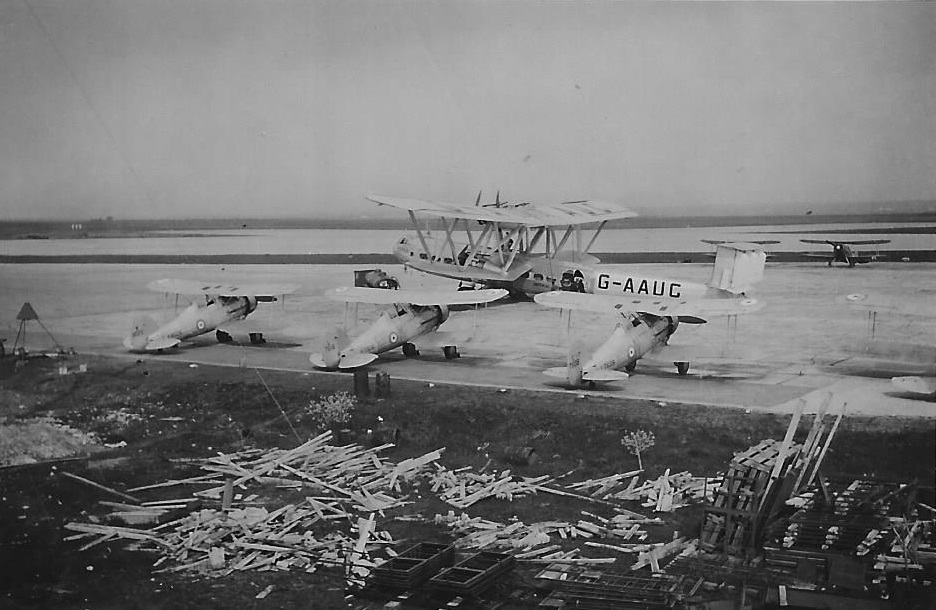 |
| No 33 (F) Sqn flight line at Lydda Airport with an Imperial Airways HP-42, Palestine 1939 |
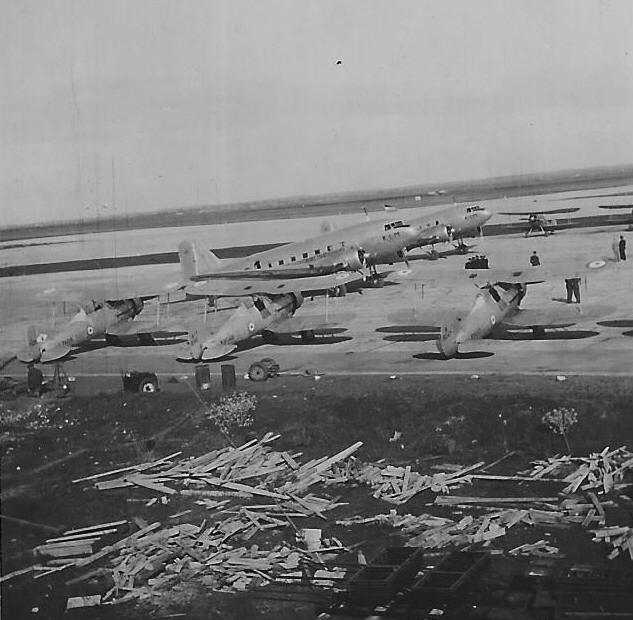 |
| 33 (F) Sqn, Lydda
Airport Palestine with two DC-2s of KLM Photos Courtesy of Roy Green's nephew, Les Green |
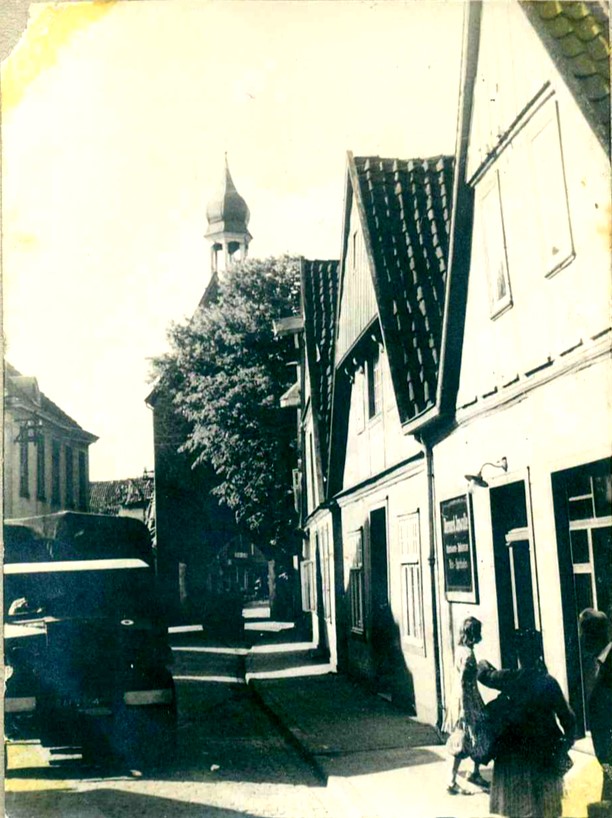 Entering Quakenbruck April 1945 |
 The ex Luftwaffe Barracks which became the Squadron’s home |
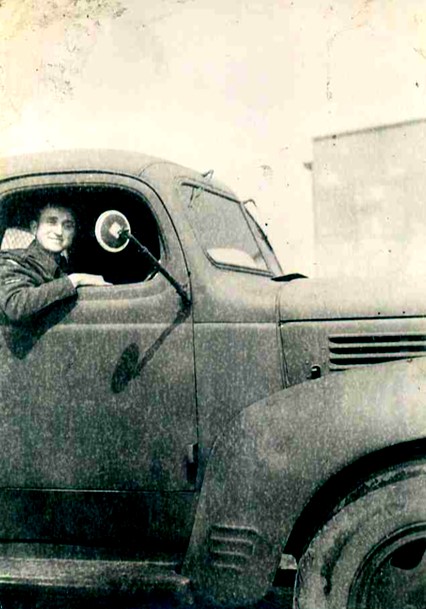
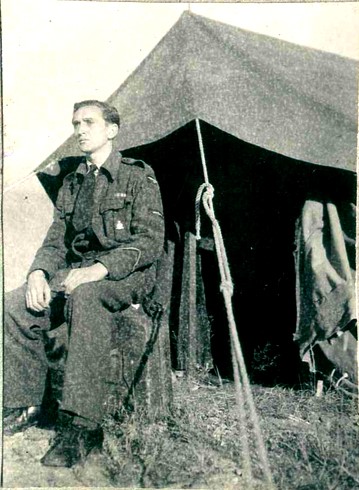 Left - Glyn Cleaves Right - Glyn Cleaves in Holland on the way out |
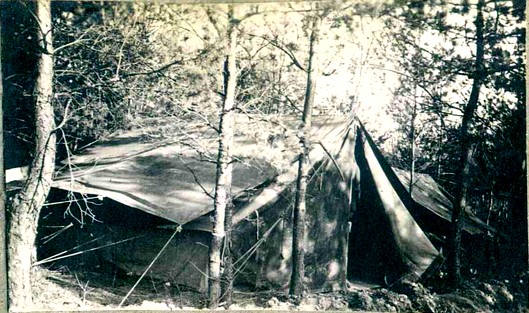
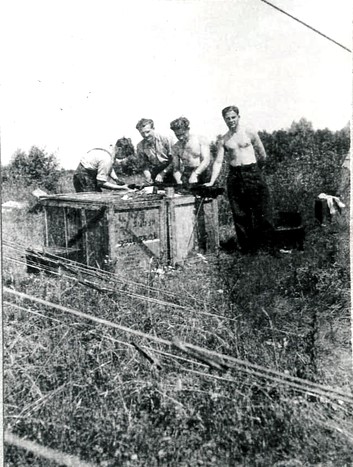 Left - A Tent in Holland Right - Tanner, Wilmot, Noon and Stewart |
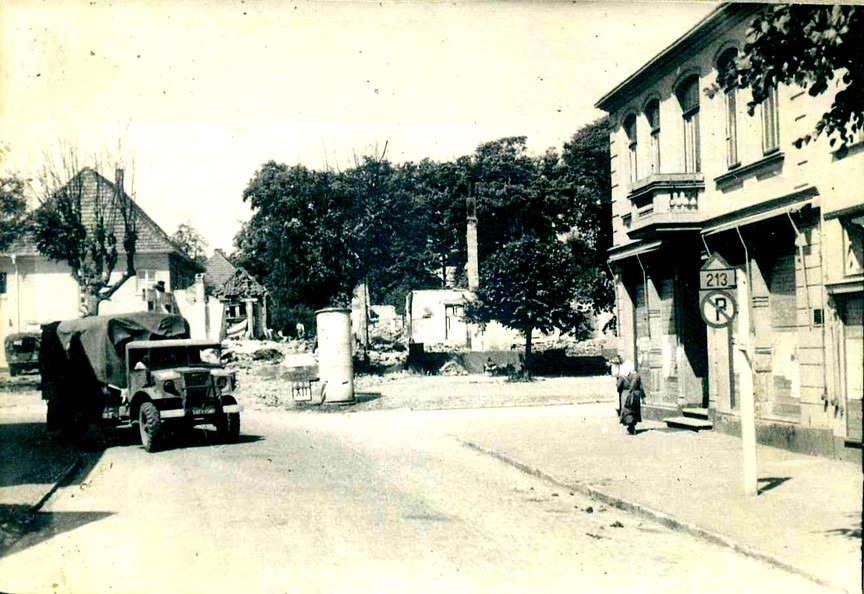 Leaving Quakenbruck for Hakensbuttel |
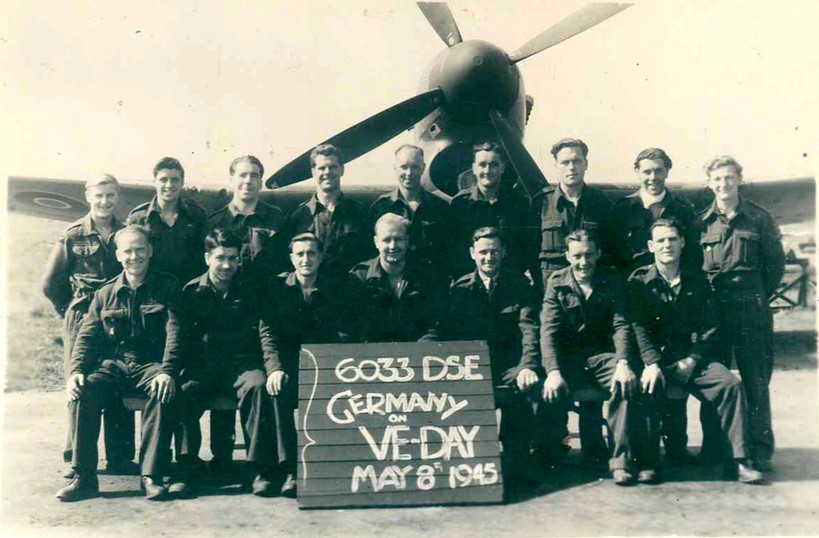 May 1945 - Glyn Cleaves front 3rd from left |
| The photos above are courtesy of Stephen Lyons |
[Aircraft & Markings | Personnel, aircraft and locations | Commanding Officers]
Goon in the Block - The story of Flt Lt D L Edy in No 33 Sqn and Stalag Luft III
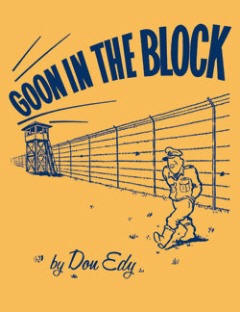
 Formed
from a nucleus of No 19 Squadron at Castle Bromwich on 7 January 1916 as a Corp
recce squadron equipped with BE2s, it moved over to France in July 1916.
Re-equipment with RE8s took place in January 1917 and in October of that year,
the squadron became part of the British force sent to support the Italians
against the Austrians, remaining there until May 1919 when it returned to the
UK; disbanding at Old Sarum on 25 September 1919.
Formed
from a nucleus of No 19 Squadron at Castle Bromwich on 7 January 1916 as a Corp
recce squadron equipped with BE2s, it moved over to France in July 1916.
Re-equipment with RE8s took place in January 1917 and in October of that year,
the squadron became part of the British force sent to support the Italians
against the Austrians, remaining there until May 1919 when it returned to the
UK; disbanding at Old Sarum on 25 September 1919.
The squadron reformed at Bircham Newton on 3 December 1935 from a nucleus supplied by No 18 Squadron. It was now equipped with Hinds in the day bomber role but these were replaced by Blenheim Is in July 1938. In August 193 the squadron was posted to Singapore, with the ground echelon leaving on the 12th and the air echelon leaving four days later. Following the Japanese invasion of Malaya in December 1941, the squadron was heavily involved and lacking re-inforcements was gradually decimated until two months later the ground echelon was withdrawn back to India.
The squadron reformed at Chakrata on 1 April 1942 with Blenheim IVs and following operations along the North-West Frontier, it began to operate against the Japanese in Burma. In April 1943, the squadron converted to Hurricanes with operations beginning again in November. Thunderbolts replaced the Hurricanes in March 1945 and these were used in ground attack operations until the end of the war, No 34 disbanding shortly afterwards on 15 October 1945.
No 34 re-surfaced on 1 August 1946, now flying Spitfires in the Photo-recce role, when No 681 Squadron was re-numbered at Palam. However, less than a year later, on 31July 1947, the squadron disbanded. The squadron was reformed in Britain on 11 February 1949 when No 695 squadron was re-numbered. The squadron was now an anti-aircraft co-operation unit flying a mixture of Beaufighters and Spitfires from Horsham St. Faith.
The squadron disbanded on 20 July 1951 but the number 34 was kept 'alive' by being linked to No 74 Squadron, also based at Horsham, this arrangement lasting until 31 July 1954. The following day No 34 was reformed in its own right as Meteor day fighter unit at Tangmere. The Meteors were replaced by Hunters in February 1956, which it flew on defensive patrols over Cyprus in October 1956 during the Suez Crisis after which it returned to the UK, where it disbanded on 10 January 1958. Its final incarnation began on 1 October 1960 when it reformed at Seletar as a Beverley equipped transport unit. It flew these in theatre until final disbandment on 31 December 1967.
| Standards | Battle Honours* |
| Award of Standard originally announced on 26 Nov 1963 , effective from 1 Apr 1963 but was never presented. | Western Front, 1916-17: Ypres, 1917: Italian Front & Adriatic, 1917-18: Somme, 1916: Hindenburg Line: Eastern Waters, 1941: Malaya, 1941-426: Arakan, 1942-44: Manipur, 1944: Burma, 1944-45: |
Squadron Codes used: -
| LB | Apr 1939 - Aug 1939 |
| EG | Sep 1939, Mar 1945 - Oct 1945 |
| 8Q | Feb 1949 - Mar 1952 |
| 6J | Feb 1949 - Jul 1951 |
[Aircraft & Markings | Personnel, aircraft and locations | Commanding Officers]
No 35 (Madras Presidency) Squadron
 Formed
at Thetford on 1 February 1916 in the Corps reconnaissance role, it was January
1917 before the squadron actually moved to France with its FK8s. On the
Western Front it operated closely with the Cavalry Corps carrying out Artillery
observation and photographic sorties. By March 1918 the chances of a
dramatic cavalry break out was obviously not going to happen so the squadron
became a general purpose unit and in October began re-equipping with Bristol
Fighters. The squadron returned to Netheravon in March 1919 where it
disbanded on 26 June.
Formed
at Thetford on 1 February 1916 in the Corps reconnaissance role, it was January
1917 before the squadron actually moved to France with its FK8s. On the
Western Front it operated closely with the Cavalry Corps carrying out Artillery
observation and photographic sorties. By March 1918 the chances of a
dramatic cavalry break out was obviously not going to happen so the squadron
became a general purpose unit and in October began re-equipping with Bristol
Fighters. The squadron returned to Netheravon in March 1919 where it
disbanded on 26 June.
The squadron was reformed in the day bomber role on 1 March 1929 at Bircham Newton, not far from its original formation location. It was initially equipped with DH9As but these had been replaced by Fairey IIIFs by the following January and Gordons had replaced these in1932. The squadron was dispatched to the Sudan in late 1935 as a result of the Abyssinian Crisis.
Returning to Worthy Down in August 1936, the squadron converted to the monoplane Wellesley the following July and in their turn Battles in April 1938. In July 1939 the squadron became a crew training unit for which it received Ansons. Together with No 90 Squadron it formed the No 1 Group Pool on 1 October 1939, equipped with Battles, Blenheims and Ansons and on 8 April 1940, the two units became No 17 OTU, thereby effectively disbanding.
When the squadron reformed on 5 November 1940, it was as the RAF's first Halifax unit, which following training and work up it took into action for the first time on the night of 10 March 1941. In August 1942 it became a founding unit in the Pathfinder Force, which later became No 8 Group, with which it remained for the remainder of the war. Lancasters arrived in March 1944 and it continued to fly these for the remainder of the war and into the post war period, carrying out a goodwill tour of the USA in July and August 1946.
Re-equipment arrived again in September 1949 when Lincolns arrived but these aircraft were short-lived as the squadron disbanded on 23 February 1950. No 35 was reborn on 1 September 1951 at Marham where it received the Boeing Washington (B29), which it flew until April 1954 when the Canberra arrived. It continued to fly these from Upwood, except for brief detachment to Cyprus in October 1956 during the Suez Crisis, until disbanding again on 11 September 1961. At the time of writing (2002), the squadron's final incarnation began on 1 December 1962 when it reformed as part of the nuclear equipped V-Force. Based at Coningsby and Cottesmore from 7 November 1964, it was equipped with the Vulcan B Mk 2. Following the hand-over of the nuclear deterrent to the Royal Navy the squadron joined the Near East Strike Force at Cyprus from 15 January 1969 until returning to Scampton on 16 January 1975. It remained at Scampton until disbanding on 1 March 1982, a month before the Argentinean invasion of the Falklands, which would see the Vulcan in action for the only time in its career.
| Standards | Battle Honours* |
| Award
of Standard originally announced on 11 Oct 1955, effective from 1 Apr 1955
but presented:-
16 Jun 1959 HRH Princess Alexandra |
Western Front, 1917-18: Arras: Lys: Ypres, 1917: Cambrai, 1917: Somme, 1918: Amiens: Biscay Ports, 1941-43: Fortress Europe, 1941-44: German Ports, 1943: Ruhr, 1943-45: Normandy, 1944: Baltic, 1944: France & Germany, 1944-45: Walcheren. |
Squadron Codes used: -
| WT | Apr 1939 - Sep 1939 |
| TL | Nov 1940 - Feb 1950 |
| FB | Sep 1950 - Apr 1951 |
[Aircraft & Markings | Personnel, aircraft and locations | Commanding Officers]
 |
| No 35 Sqn - 1917 |
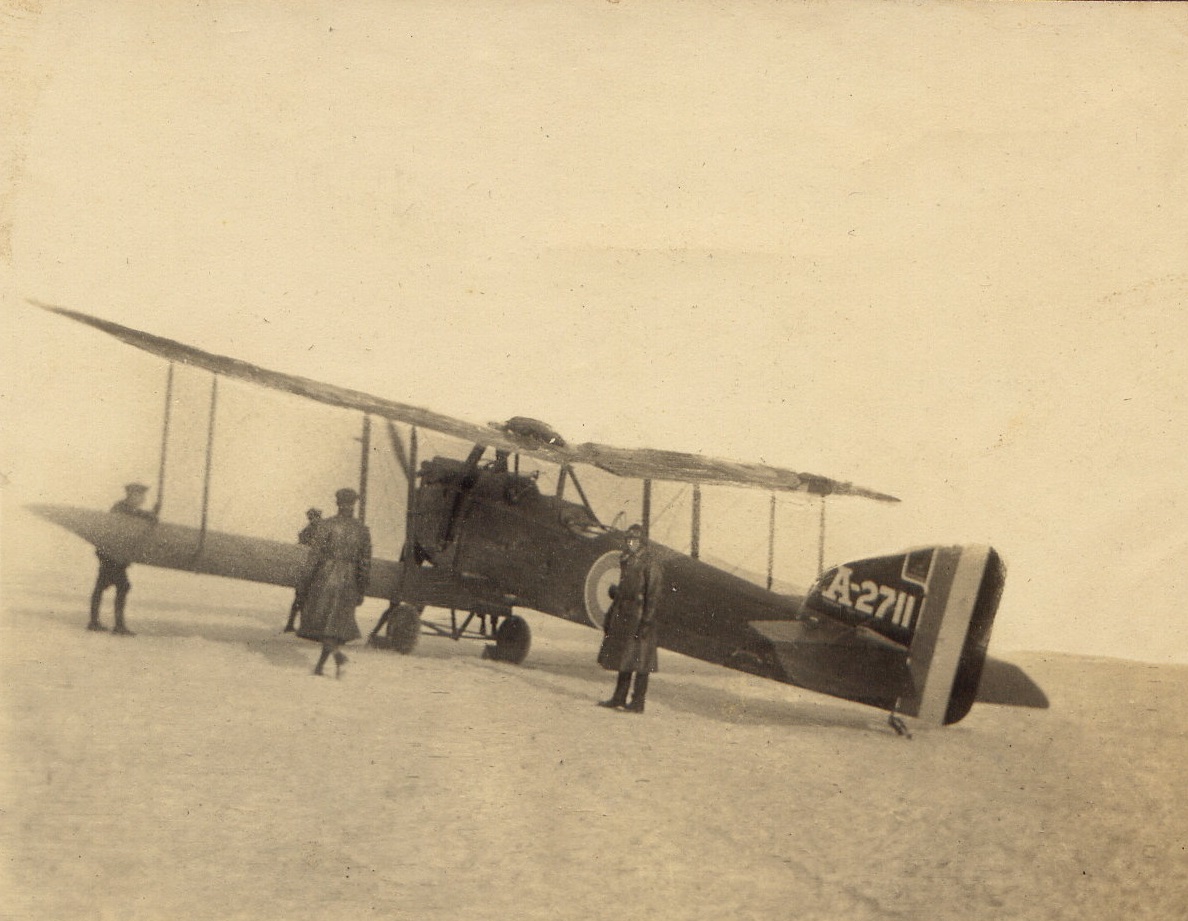 |
| Armstrong Whitworth FK8 of No 35 Sqn |
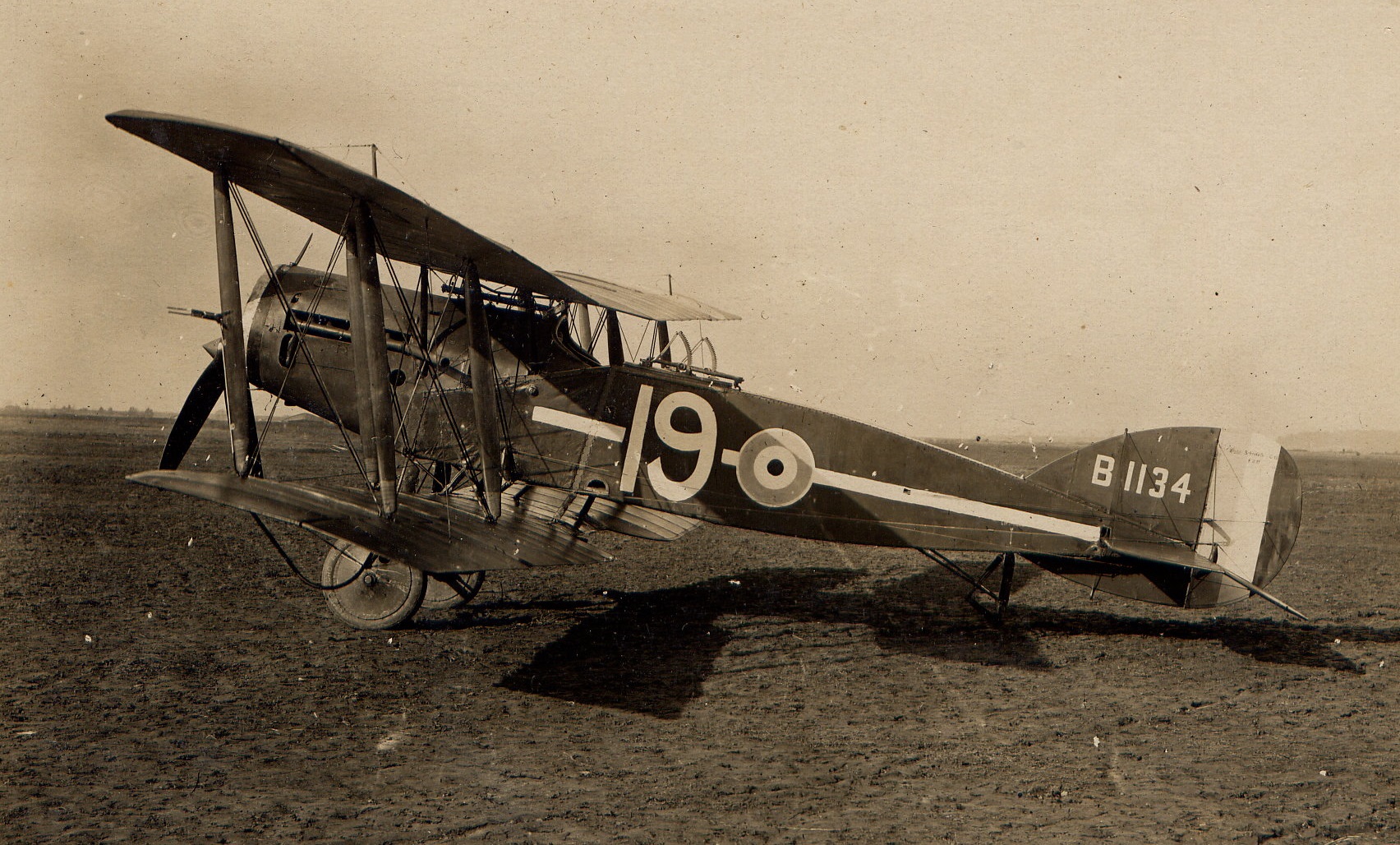 |
| Bristol F2B of No 35 Sqn |
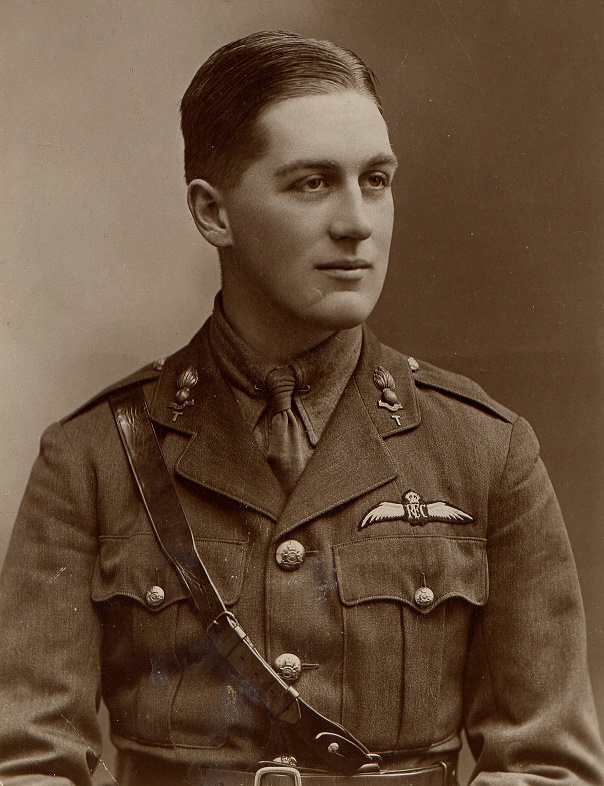 |
| Richard Nigel Walton |
| Photos Courtesy - Robert White (from the album of his grandfather Richard Nigel Walton) |
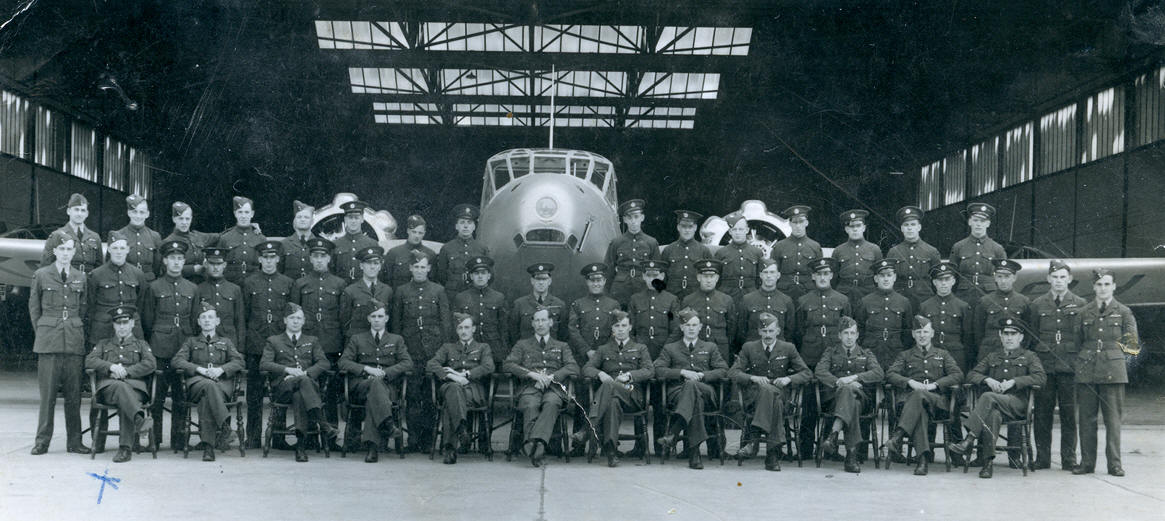 |
| No 35 (Bomber) Sqn - RAF
Cottesmore Photo Courtesy - Ben Cote (his grandfather, John McMorron is marked with the blue cross) |
No 35 Squadron Association: - Bill Stevenson, 20, Chapel Close, Saughall, Chester CH1 6DQ Tel:- 01244 657902
*Honours in Black are those the squadron has a been granted the right to emblazon on the Squadron Standard, but does not do so.
Honours in Red are those actually emblazoned on the Squadron Standard
Honours in Blue are those the squadron has not been granted the right to emblazon on the Squadron Standard
Squadron badges on this page are courtesy of Dave Clifford
Badges of squadrons marked # have been produced by Mary Denton on behalf of the RAF Heraldry Trust and are displayed on this page with the permission of the RAFHT. Mary Denton and the RAFHT have probably completed half of the 'official' badges authorised but are still looking for sponsorship for the remaining badges. The work continues and details can be found on their website.
© Crown Copyright is reproduced with the permission of the Directorate of Intellectual Property Rights
This page was last updated on 17/03/25©
![]() Organisational
Index
[Top of page]
Sqns 36 - 40
Organisational
Index
[Top of page]
Sqns 36 - 40
![]()